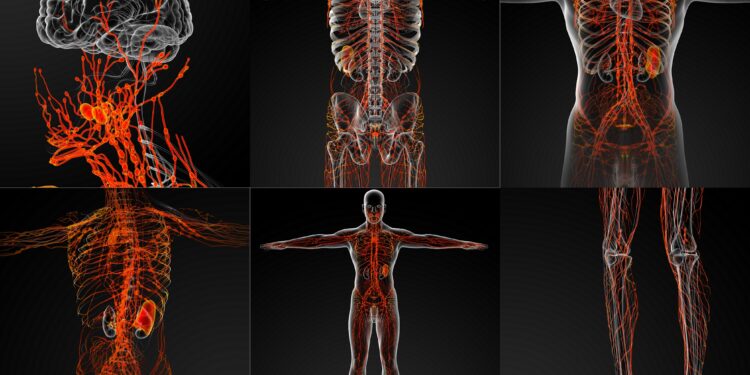
—
How cancer spreads through the lymphatic system
The formation of metastases, in other words the development of daughter tumors, is the greatest danger in cancer and the most common cause of death from cancer. The prevention of metastases is a central concern in cancer research. A German working group has now found a new method of how the metastasis of cancerous ulcers can possibly be prevented.
Researchers from the German Cancer Research Center and the Mannheim Medical Faculty at Heidelberg University are looking for new ways to prevent tumor metastasis. The team came across a potential way of averting the formation of metastases via the lymphatic system. The research results were recently published in the journal “Cancer Discovery” presents.
How do metastases develop?
Cancer cells can peel off a tumor and travel around the body to form a new cancerous growth elsewhere. There are two ways for cancer cells to do this: the bloodstream and the lymphatic system – because almost all cells in the body are connected to these systems. The blood vessels deliver oxygen and nutrients to the cells, the lymph vessels transport cells of the immune system and tissue fluids.
Which path do cancer cells prefer?
So far it is unclear which route cancer cells prefer to metastasize. The new research work of the German Cancer Research Center sheds some light on this. For the first time, the researchers are using mice to demonstrate the importance of the route via lymphatic vessels in the formation of metastases and which biological mechanisms play a role in this. The team also looked for ways to block the dangerous spread of tumor cells via the lymphatic system.
Implanted tumors open up new insights
In previous studies, the complicated architecture of tumors failed to investigate the spread of cancer in living organisms. Hellmut Augustin’s research team has now developed a completely new animal model for this purpose.
“The key to this was the direct transplantation of tumor tissue from one mouse to another without prior cell culture,” explains the head of research. In this way, the natural tissue structure is preserved and the cancer tumors can develop functional lymph vessels that are connected to the lymphatic system. This is the prerequisite for lymphogenic metastasis.
A messenger substance ensures the survival of the cancer cells
With the help of the model, the researchers were able to document the formation of metastases via the lymphatic system in a living organism. For example, it was confirmed that the cancer cells initially migrate to nearby lymph nodes. From there they attack other organs. The team also discovered that a certain messenger substance, which is produced by cells in the outer wall of the lymphatic vessels, ensures the survival of the migrating cancer cells. When the researchers blocked the messenger substance angiopoietin 2, the cancer cells also died and there were significantly fewer metastases, which means that the mice survived significantly longer.
Cancer cells often stay in the body after surgery
With the new model, the researchers were also able to simulate situations that often occur after cancer operations: the tumor has been removed, but malignant cancer cells remain in the body, which makes it possible to relapse. In this case, too, blocking the lymph vessel messenger could help.
“Surprisingly, we were able to effectively prevent the spread of the tumors in the mice even if we only blocked angiopoietin-2 shortly before the tumor operation,” sums up Augustin. So far, the therapeutic effect has only been confirmed in animals. The next step is to test the treatment on people. (vb)
Author and source information
This text complies with the requirements of specialist medical literature, medical guidelines and current studies and has been checked by medical professionals.
–
Author:
Diploma-Editor (FH) Volker Blasek
–
Sources:
- German Cancer Research Center: How the spread of tumor cells via the lymphatic vessels can be prevented (published: October 26, 2020), dkfz.de
- Nicolas Gengenbacher, Mahak Singhal, Carolin Mogler, u.a.: Timed Ang2-targeted therapy identifies the Angiopoietin-Tie pathway as key regulator of fatal lymphogenous metastasis; in: Cancer Discovery, 2020, cancerdiscovery.aacrjournals.org
–
–
–
Important NOTE:
This article is for general guidance only and should not be used for self-diagnosis or self-treatment. He can not substitute a visit at the doctor.
–
– .


